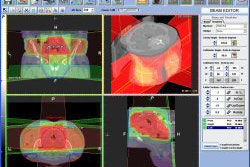Call it the eBay of radiology: A new firm called Telerays has developed a novel Web-based auction approach to teleradiology services that calls for readings to be awarded to the lowest bidder. The company is currently recruiting radiologists to sign up to provide readings and is marketing its services to hospitals and imaging centers.
Telerays is developing an online marketplace in which facilities that need reading services put projects out to bid. Radiologists who are certified by the firm will be able to bid on the projects, with the lowest bidder winning the project. The company believes its model has the potential to revolutionize the way imaging services are provided, in much the same way that teleradiology itself revolutionized radiology.
"The idea is for Telerays to be providing a truly virtual reading room," said Daniel Roubein, president of the company. "Hospitals and imaging centers, after the projects have been awarded and in a secure environment, transfer the case, allow the preapproved radiologist to download the images, interpret the case, upload the report and then [are] downloaded by the appropriate facility, all in [Health Insurance Portability and Accountability Act] HIPAA-compliant and password-protected environments."
Hospitals and imaging centers can use their own PACS, or Telerays will direct them to any of several PACS suppliers. All workstations must meet American College of Radiology (ACR) criteria. Telerays does not contract with any particular PACS supplier.
The company's Web site, www.telerays.com, offers hospitals and imaging centers access to radiologists around the country. For radiologists, the approach provides the opportunity to choose their cases, work when they want, and decide what the work is worth to them. It also saves radiologists the cost of billing.
"Telerays is ... a great equalizer, and it basically allows small hospitals and imaging centers access to the best doctors anywhere immediately," Roubein said. "It also allows hospitals and imaging centers to have access to competitive pricing that we're facilitating, even if they're in larger cities with higher costs of living."
After the first week of posting recruitment information on the ACR's Web site, the company received more than 500 inquiries. Roubein says that as Telerays grows, he foresees that the number of radiologists bidding on projects will increase.
"The auction tool is something I think has become a really comfortable mechanism for many industries," says Roubein. "To me it's a natural progression for teleradiology."
How it works
To become part of the network, radiologists submit their credentials to Telerays. Actual copies of licenses, not just listings, are submitted. Telerays also requires a copy of radiologists' American Board of Radiology (ABR) certification.
"We use credentialing methods that are similar to those in the teleradiology and radiology world ... to make sure we are aligned with those and can feel confident about the information that we're putting forward," Roubein said.
Prior to posting a project on the Web site, a hospital or imaging center registers with Telerays and has preapproved radiologists to participate in the auction. The hospital or imaging center decides the length of the auction and sets a ceiling on the price it is willing to pay. Preapproved radiologists bid on the project, and the lowest bid wins. If the lowest bid is duplicated by another radiologist, the first of the duplicate low bid gets the contract.
The length of the auction period is posted on the Web site and will typically last between one and three days. "If [a hospital] places an auction for a certain amount and no one bids, then they would logically draw the conclusion that they may have offered too low a fee," Roubein said.
The hospital or imaging center and the bidding radiologist establish the price. Telerays has no input regarding what the price will be, but receives 15% of the hospital or imaging center's fee paid to the radiologist.
Radiologists who bid on projects agree to read cases in a time frame that would eliminate delays. "If it's an emergency case situation, they would have agreed on that [time frame] ahead of time," Roubein says. "We're definitely going to ... make sure there are no delays in diagnosis and that no process we're using ... would cause any delay."
For emergency coverage, a hospital or imaging center posts the project on an auction a month prior to the needed time, such as a weekend afternoon, to read the emergency cases. They then know who is covering and what the turnaround time would be.
As hospitals determine that they have a fixed number of MRI studies in a particular month, in the first week of the prior month they would hold an auction that ran for 48 hours to post the project. They would have already credentialed through the Telerays Web site for 20 radiologists or one group of 10 radiologists and five independents, for example, who all are available to bid. The number of bidding radiologists is determined by the hospital or imaging center.
After reading the images, the radiologists submit final reports. Eliminating preliminary reports offers a cost savings to hospitals and imaging centers. If a second opinion is required from another expert, then it is incumbent upon the radiologist doing the first reading to do due diligence, take the extra steps needed for the case, and then submit the report.
"It's exactly the way we practice radiology now all over the country," Roubein said.
Telerays has no exclusivity requirement with radiologists in the network. Radiologists can work with other teleradiology services or other practices. "We have no membership fee to be a part of our network, and this offers opportunity for supplemental income," Roubein said. "They have a higher earning potential with us because they set the fee, and they have an opportunity to negotiate for themselves and actually keep a larger percentage of the monies that are generated by the radiology interpretations."
In addition, Telerays can provide radiologists with access to cases they have no other way of reaching. "We're enabling radiologists to start radiology practices or grow their existing teleradiology practices by offering them the opportunity to see these projects," said Roubein. Most of the projects will be long-term, lasting one to three months.
Change isn't easy
Some criticism of auctioning radiology interpretations includes that of commoditizing radiology. Roubein attributes such charges to resistance to change.
"This [approach] is a natural evolution for the practice of teleradiology," he said. "It's important to remember that teleradiology itself was extremely hard for radiologists and the medical community to accept 10 years ago. This is a similar change in the paradigm in the way teleradiology is practiced. This is a method for more control ... in the hands of radiologists in terms of the fees that are charged by them, and I think that is very important."
Roubein sees the auction approach as a win-win situation for hospitals, imaging centers, and radiologists. "It really becomes a matter of evaluating the process in terms of the quality it offers and realizing that although change may be difficult, the application of the free market system to teleradiology and the connecting of people ... will become the norm in the practice of radiology and teleradiology in the future," Roubein said.
By Lin Muschlitz
AuntMinnie.com staff writer
October 16, 2008
Related Reading
Teleradiology offers opportunities, challenges, August 25, 2008
Teleradiology: A threat to local practices? April 22, 2008
MGH teleradiology plan rankles Rhode Island radiologists, April 3, 2007
Survey says rads are considering teleradiology, May 3, 2006
Copyright © 2008 AuntMinnie.com



















